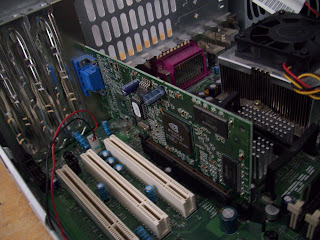Un-Assembly
1. Take Case Off
2. Take all cords out of respective spots
3. Remove Disc Drive
4. Remove Floppy Drive
5. Unscrew Fans
6. Unplug Fan and Remove
7. Remove USB plugs
8. Remove Power Supply
9. Take RAM and ROM Out
Assembling It
1. Put RAM and ROM back in
2. Put the power supply back in
3. Put USB plugs in respective holes
4. Put fan back in
5. Screw Fans back in
6. Put Floopy Drive In
7. Put Disc Drive Back in
8. Re-apply all cords to appropriate spots
9. Put Case On
Tuesday, October 26, 2010
Thursday, September 30, 2010
E-WASTE
E-WASTE is generally an issue for the whole world to put up with. It leaks personal information to people that really shouldn't be leaked. Personal information such as credit cards, adresses, important acounts and bills and payments become accessible to any person where E-WASTE is dumped.
Many Asian countries have access to all the information in the world through E-WASTE, with their own technological advances on us they could easily take control of the whole electronic Earth. With access to all credit card information it makes it easy to scam them and use their numbers and duplicate cards at stores, making you pay their huge credit bill. With your personal information it makes it easier to get into your credit card and also would give them access to any money source you have of you own. Furthermore they could also completely become you, by using your information for ID's, Birth Certificates, Credit and Bank Cards, and all of the other things that could completely ruin your life.
Why do they have this information? They have all of this information because people bring their computers without wiping them to be thrown out. Also computer companies generally don't take the time to wipe computers when they are sent back, causing the previous owner of the computer to leak information to people who shouldn't have it.
The main importer of E-WASTE is North America, creating tonnes and tonnes of E-WASTE and dumping it into countries like Accra, China, and Ghana.
Motivational Poster Creator
Picture Source
Thursday, September 23, 2010
Hardware Technology
Internal!!:
Motherboards: A motherboard is the central printed circuit board (PCB) in many modern computers and holds many of the crucial components of the system, while providing connectors for other peripherals. ...
A few similiar factors are shapes, chipsets, color, card slots, cpu's
CPU's: (Central Processing Unit) The central processing unit (CPU) is the portion of the computers that carries out all of the computers program running settings
PC Cooling System: keeps a computer cool and is required so a computer does not overheat and crash.
ROM: Read-only memory is a form of memory that can only be read and not edited. It usually consists of all of the software needed to run main hardware parts.
RAM: Random-access memory (RAM) is a basically how fast your computer is able to go. The more RAM you have the faster your computer will go.
Adaptor Cards: The expansion card (also expansion board, adapter card or accessory card) in computing is a chip that can be added to the mother board to expand a computer's capabilities.
-------------------------------------------------------------------------------------------------------
Storage Drives!!:
Hard Drive: is a drive that stores all of the memory in your computer system.
Floppy Drive: reads floppy disc memory
Optical Drive: is a drive used to read optical disc memory
-----------------------------------------------------------------------------------------------------
Cables!!:
Molex: a power source of the computer that supplies it with energy.
Berg: Smaller version of a Molex.
PATA: Parallel ATA (PATA) is an interface standard for connecting drives to the computer
SATA: Serial ATA (SATA or Serial Advanced Technology Attachment) is a stronger form of PATA that allows you to attach Hard disks to the computer and such.
Motherboards: A motherboard is the central printed circuit board (PCB) in many modern computers and holds many of the crucial components of the system, while providing connectors for other peripherals. ...
A few similiar factors are shapes, chipsets, color, card slots, cpu's
CPU's: (Central Processing Unit) The central processing unit (CPU) is the portion of the computers that carries out all of the computers program running settings
PC Cooling System: keeps a computer cool and is required so a computer does not overheat and crash.
ROM: Read-only memory is a form of memory that can only be read and not edited. It usually consists of all of the software needed to run main hardware parts.
RAM: Random-access memory (RAM) is a basically how fast your computer is able to go. The more RAM you have the faster your computer will go.
Adaptor Cards: The expansion card (also expansion board, adapter card or accessory card) in computing is a chip that can be added to the mother board to expand a computer's capabilities.
-------------------------------------------------------------------------------------------------------
Storage Drives!!:
Hard Drive: is a drive that stores all of the memory in your computer system.
Floppy Drive: reads floppy disc memory
Optical Drive: is a drive used to read optical disc memory
-----------------------------------------------------------------------------------------------------
Cables!!:
Molex: a power source of the computer that supplies it with energy.
Berg: Smaller version of a Molex.
PATA: Parallel ATA (PATA) is an interface standard for connecting drives to the computer
SATA: Serial ATA (SATA or Serial Advanced Technology Attachment) is a stronger form of PATA that allows you to attach Hard disks to the computer and such.
Subscribe to:
Posts (Atom)














